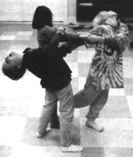Movement Strategies

Feeling the pull of checks and balances described in the U.S. Constitution.
Kinesthetic Activity:
A mechanical use of the body to express a process, idea, or feeling with minimal regard to aesthetics. For example, showing a punctuation mark, a parallel circuit, or the circulatory system.
Conversation:
A responsive interplay of movements between 2 or 3 people or groups. Each party moves while the other freezes. For example, showing the interaction of two characters in a story, or creating inter-related shapes to express spatial prepositions.
Improvisation:
Creative, spontaneous, interpretive movements to express ideas and/or feelings through the elements of dance. For example, spontaneously interpreting a poem or story through movement.
Journey:
Traveling sequentially through time and/or space, associating specific content with each physical area. For example, escaping on the Underground Railroad, cycling through the seasons, or showing the life cycle of a salmon.
Tableau:
A frozen group sculpture of bodies using interesting shapes and variety of levels to express a common theme. These can also be done in a series of three or four. For instance, showing the main idea of a story or poem, showing the stages of metamorphosis of a butterfly, showing historical events.
Choreography:
Creating and planning repeatable movements with a conscious use of shape, time, space and motion to express ideas and/or feelings; involves brainstorming, revising, transitions, editing.
For instance, choreographing an interpretation of a poem, or creating a dance of the water cycle.
Authentic Dance Forms:
Dance with its own vocabulary and technique from a particular culture or time period. For instance, Native American dances, Colonial dances, hip hop, or ballet.
“Dance is action and shape
designed in space and time
to express feelings and ideas.”
—Bill T. Jones
